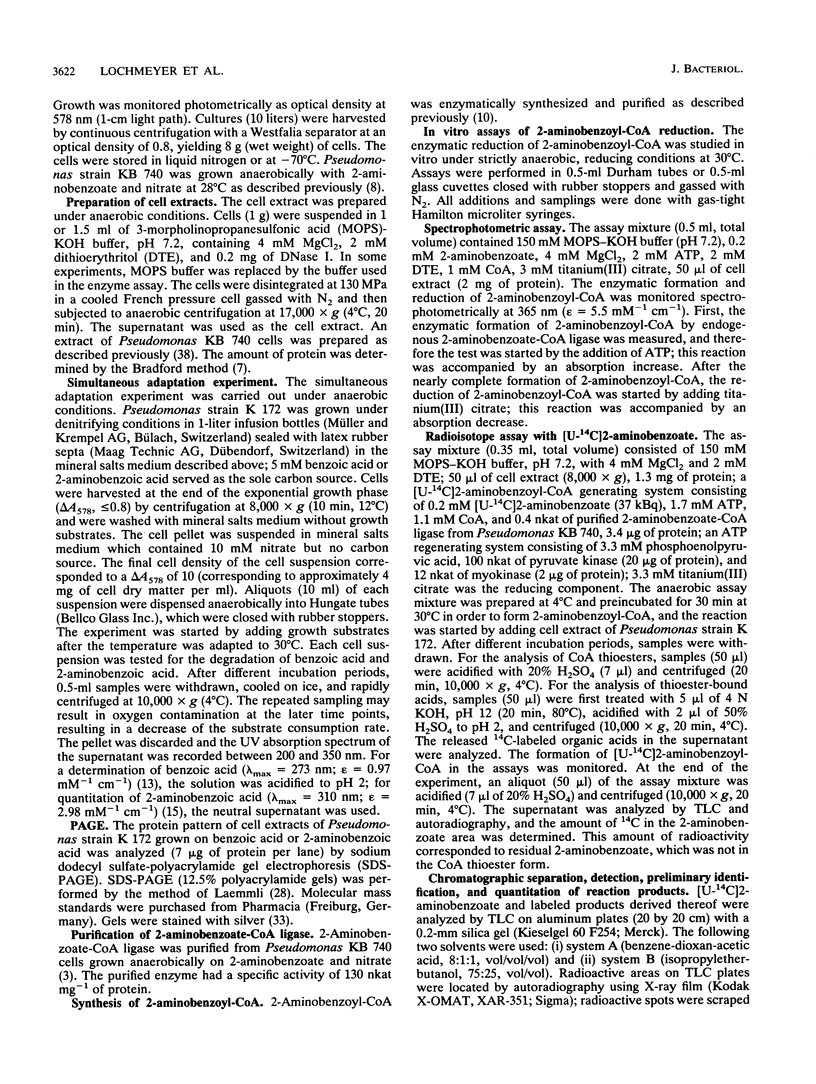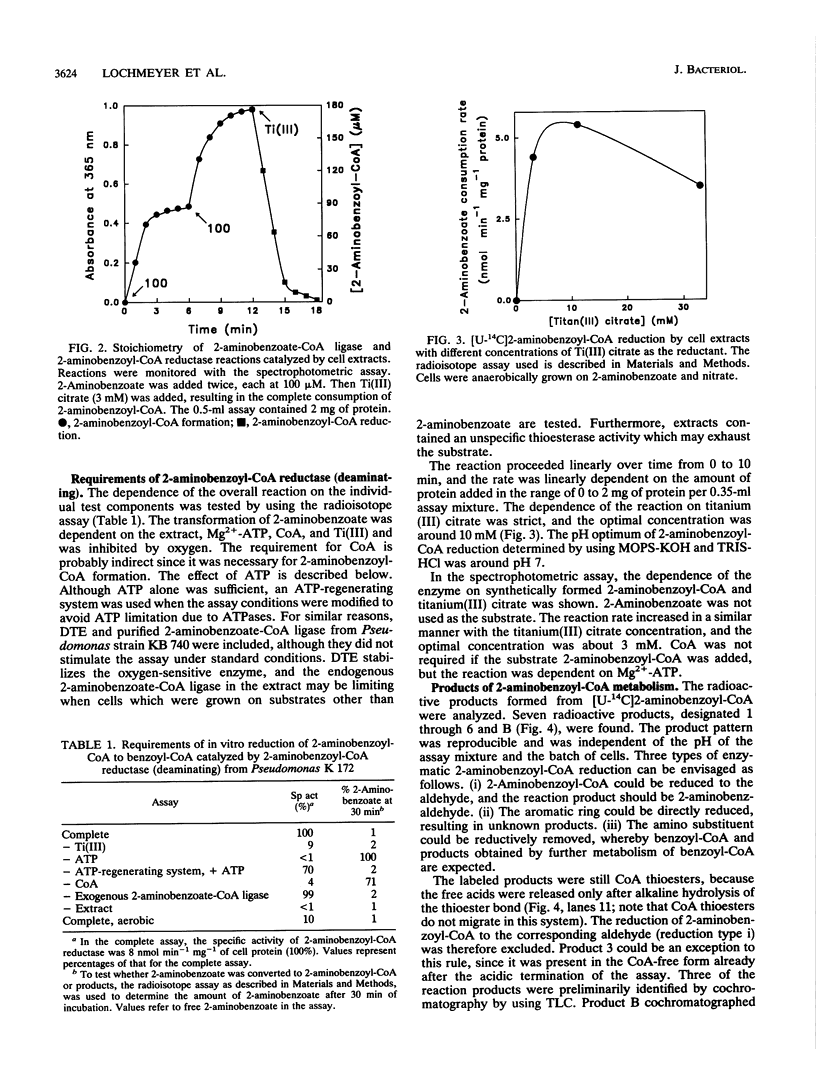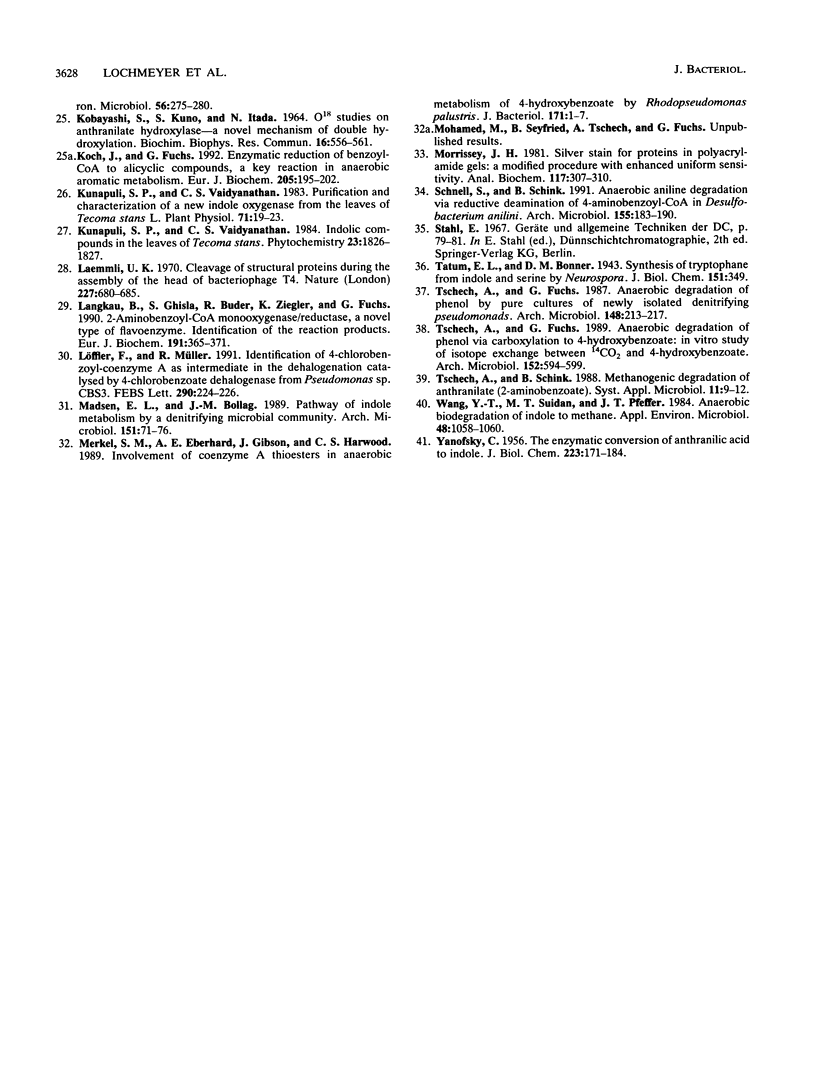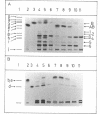Abstract
The enzymes catalyzing the initial reactions in the anaerobic degradation of 2-aminobenzoic acid (anthranilic acid) were studied with a denitrifying Pseudomonas sp. anaerobically grown with 2-aminobenzoate and nitrate as the sole carbon and energy sources. Cells grown on 2-aminobenzoate are simultaneously adapted to growth with benzoate, whereas cells grown on benzoate degrade 2-aminobenzoate several times less efficiently than benzoate. Evidence for a new reductive pathway of aromatic metabolism and for four enzymes catalyzing the initial steps is presented. The organism contains 2-aminobenzoate-coenzyme A ligase (2-aminobenzoate-CoA ligase), which forms 2-aminobenzoyl-CoA. 2-Aminobenzoyl-CoA is then reductively deaminated to benzoyl-CoA by an oxygen-sensitive enzyme, 2-aminobenzoyl-CoA reductase (deaminating), which requires a low potential reductant [Ti(III)]. The specific activity is 15 nmol of 2-aminobenzoyl-CoA reduced min-1 mg-1 of protein at an optimal pH of 7. The two enzymes are induced by the substrate under anaerobic conditions only. Benzoyl-CoA is further converted in vitro by reduction with Ti(III) to six products; the same products are formed when benzoyl-CoA or 2-aminobenzoyl-CoA is incubated under reducing conditions. Two of them were identified preliminarily. One product is cyclohex-1-enecarboxyl-CoA, the other is trans-2-hydroxycyclohexane-carboxyl-CoA. The complex transformation of benzoyl-CoA is ascribed to at least two enzymes, benzoyl-CoA reductase (aromatic ring reducing) and cyclohex-1-enecarboxyl-CoA hydratase. The reduction of benzoyl-CoA to alicyclic compounds is catalyzed by extracts from cells grown anaerobically on either 2-aminobenzoate or benzoate at almost the same rate (10 to 15 nmol min-1 mg-1 of protein). In contrast, extracts from cells grown anaerobically on acetate or grown aerobically on benzoate or 2-aminobenzoate are inactive. This suggests a sequential induction of the enzymes.
Full text
PDF







Images in this article
Selected References
These references are in PubMed. This may not be the complete list of references from this article.
- Altenschmidt U., Eckerskorn C., Fuchs G. Evidence that enzymes of a novel aerobic 2-amino-benzoate metabolism in denitrifying Pseudomonas are coded on a small plasmid. Eur J Biochem. 1990 Dec 12;194(2):647–653. doi: 10.1111/j.1432-1033.1990.tb15664.x. [DOI] [PubMed] [Google Scholar]
- Altenschmidt U., Fuchs G. Anaerobic degradation of toluene in denitrifying Pseudomonas sp.: indication for toluene methylhydroxylation and benzoyl-CoA as central aromatic intermediate. Arch Microbiol. 1991;156(2):152–158. doi: 10.1007/BF00290990. [DOI] [PubMed] [Google Scholar]
- Altenschmidt U., Oswald B., Fuchs G. Purification and characterization of benzoate-coenzyme A ligase and 2-aminobenzoate-coenzyme A ligases from a denitrifying Pseudomonas sp. J Bacteriol. 1991 Sep;173(17):5494–5501. doi: 10.1128/jb.173.17.5494-5501.1991. [DOI] [PMC free article] [PubMed] [Google Scholar]
- Anderson J. J., Dagley S. Catabolism of tryptophan, anthranilate, and 2,3-dihydroxybenzoate in Trichosporon cutaneum. J Bacteriol. 1981 Apr;146(1):291–297. doi: 10.1128/jb.146.1.291-297.1981. [DOI] [PMC free article] [PubMed] [Google Scholar]
- Balba M. T., Evans W. C. Methanogenic fermentation of the naturally occurring aromatic amino acids by a microbial consortium. Biochem Soc Trans. 1980 Oct;8(5):625–627. doi: 10.1042/bst0080625. [DOI] [PubMed] [Google Scholar]
- Berry D. F., Madsen E. L., Bollag J. M. Conversion of indole to oxindole under methanogenic conditions. Appl Environ Microbiol. 1987 Jan;53(1):180–182. doi: 10.1128/aem.53.1.180-182.1987. [DOI] [PMC free article] [PubMed] [Google Scholar]
- Bradford M. M. A rapid and sensitive method for the quantitation of microgram quantities of protein utilizing the principle of protein-dye binding. Anal Biochem. 1976 May 7;72:248–254. doi: 10.1006/abio.1976.9999. [DOI] [PubMed] [Google Scholar]
- Braun K., Gibson D. T. Anaerobic degradation of 2-aminobenzoate (anthranilic acid) by denitrifying bacteria. Appl Environ Microbiol. 1984 Jul;48(1):102–107. doi: 10.1128/aem.48.1.102-107.1984. [DOI] [PMC free article] [PubMed] [Google Scholar]
- Buder R., Ziegler K., Fuchs G., Langkau B., Ghisla S. 2-Aminobenzoyl-CoA monooxygenase/reductase, a novel type of flavoenzyme. Studies on the stoichiometry and the course of the reaction. Eur J Biochem. 1989 Nov 20;185(3):637–643. doi: 10.1111/j.1432-1033.1989.tb15160.x. [DOI] [PubMed] [Google Scholar]
- Dolfing J., Tiedje J. M. Growth yield increase linked to reductive dechlorination in a defined 3-chlorobenzoate degrading methanogenic coculture. Arch Microbiol. 1987;149(2):102–105. doi: 10.1007/BF00425073. [DOI] [PubMed] [Google Scholar]
- Egebo L. A., Nielsen S. V., Jochimsen B. U. Oxygen-dependent catabolism of indole-3-acetic acid in Bradyrhizobium japonicum. J Bacteriol. 1991 Aug;173(15):4897–4901. doi: 10.1128/jb.173.15.4897-4901.1991. [DOI] [PMC free article] [PubMed] [Google Scholar]
- Evans W. C. Biochemistry of the bacterial catabolism of aromatic compounds in anaerobic environments. Nature. 1977 Nov 3;270(5632):17–22. doi: 10.1038/270017a0. [DOI] [PubMed] [Google Scholar]
- Evans W. C., Fuchs G. Anaerobic degradation of aromatic compounds. Annu Rev Microbiol. 1988;42:289–317. doi: 10.1146/annurev.mi.42.100188.001445. [DOI] [PubMed] [Google Scholar]
- Fujioka M., Wada H. The bacterial oxidation of indole. Biochim Biophys Acta. 1968 Apr 16;158(1):70–78. doi: 10.1016/0304-4165(68)90073-1. [DOI] [PubMed] [Google Scholar]
- Geissler J. F., Harwood C. S., Gibson J. Purification and properties of benzoate-coenzyme A ligase, a Rhodopseudomonas palustris enzyme involved in the anaerobic degradation of benzoate. J Bacteriol. 1988 Apr;170(4):1709–1714. doi: 10.1128/jb.170.4.1709-1714.1988. [DOI] [PMC free article] [PubMed] [Google Scholar]
- Glöckler R., Tschech A., Fuchs G. Reductive dehydroxylation of 4-hydroxybenzoyl-CoA to benzoyl-CoA in a denitrifying, phenol-degrading Pseudomonas species. FEBS Lett. 1989 Jul 17;251(1-2):237–240. doi: 10.1016/0014-5793(89)81461-9. [DOI] [PubMed] [Google Scholar]
- Harwood C. S., Gibson J. Uptake of benzoate by Rhodopseudomonas palustris grown anaerobically in light. J Bacteriol. 1986 Feb;165(2):504–509. doi: 10.1128/jb.165.2.504-509.1986. [DOI] [PMC free article] [PubMed] [Google Scholar]
- Kobayashi S., Kuno S., Itada N., Hayaishi O., Kozuka S., Oae S. O-18 studies on anthranilate hydroxylase--a novel mechanism of double hydroxylation. Biochem Biophys Res Commun. 1964 Aug 11;16(6):556–561. doi: 10.1016/0006-291x(64)90192-5. [DOI] [PubMed] [Google Scholar]
- Koch J., Fuchs G. Enzymatic reduction of benzoyl-CoA to alicyclic compounds, a key reaction in anaerobic aromatic metabolism. Eur J Biochem. 1992 Apr 1;205(1):195–202. doi: 10.1111/j.1432-1033.1992.tb16768.x. [DOI] [PubMed] [Google Scholar]
- Kunapuli S. P., Vaidyanathan C. S. Purification and Characterization of a New Indole Oxygenase from the Leaves of Tecoma stans L. Plant Physiol. 1983 Jan;71(1):19–23. doi: 10.1104/pp.71.1.19. [DOI] [PMC free article] [PubMed] [Google Scholar]
- Laemmli U. K. Cleavage of structural proteins during the assembly of the head of bacteriophage T4. Nature. 1970 Aug 15;227(5259):680–685. doi: 10.1038/227680a0. [DOI] [PubMed] [Google Scholar]
- Langkau B., Ghisla S., Buder R., Ziegler K., Fuchs G. 2-Aminobenzoyl-CoA monooxygenase/reductase, a novel type of flavoenzyme. Identification of the reaction products. Eur J Biochem. 1990 Jul 31;191(2):365–371. doi: 10.1111/j.1432-1033.1990.tb19131.x. [DOI] [PubMed] [Google Scholar]
- Löffler F., Müller R. Identification of 4-chlorobenzoyl-coenzyme A as intermediate in the dehalogenation catalyzed by 4-chlorobenzoate dehalogenase from Pseudomonas sp. CBS3. FEBS Lett. 1991 Sep 23;290(1-2):224–226. doi: 10.1016/0014-5793(91)81265-a. [DOI] [PubMed] [Google Scholar]
- Merkel S. M., Eberhard A. E., Gibson J., Harwood C. S. Involvement of coenzyme A thioesters in anaerobic metabolism of 4-hydroxybenzoate by Rhodopseudomonas palustris. J Bacteriol. 1989 Jan;171(1):1–7. doi: 10.1128/jb.171.1.1-7.1989. [DOI] [PMC free article] [PubMed] [Google Scholar]
- Morrissey J. H. Silver stain for proteins in polyacrylamide gels: a modified procedure with enhanced uniform sensitivity. Anal Biochem. 1981 Nov 1;117(2):307–310. doi: 10.1016/0003-2697(81)90783-1. [DOI] [PubMed] [Google Scholar]
- Tschech A., Fuchs G. Anaerobic degradation of phenol by pure cultures of newly isolated denitrifying pseudomonads. Arch Microbiol. 1987 Sep;148(3):213–217. doi: 10.1007/BF00414814. [DOI] [PubMed] [Google Scholar]
- Wang Y. T., Suidan M. T., Pfeffer J. T. Anaerobic biodegradation of indole to methane. Appl Environ Microbiol. 1984 Nov;48(5):1058–1060. doi: 10.1128/aem.48.5.1058-1060.1984. [DOI] [PMC free article] [PubMed] [Google Scholar]
- YANOFSKY C. The enzymatic conversion of anthranilic acid to indole. J Biol Chem. 1956 Nov;223(1):171–184. [PubMed] [Google Scholar]



